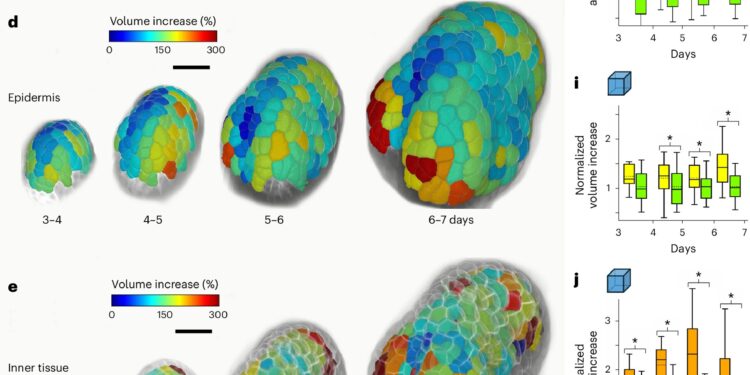The localized growth of the internal fabric underpins the formation of the lobe. Credit: Natural plants (2025). DOI: 10.1038 / S41477-025-01944-8
Plants are not content to grow, they are built. From imposing trees to delicate flowers, the complex shapes of the plants are carved with remarkable precision. Now, a study of biologists and biophysicists of the University of Montreal reveals how plants build their three -dimensional organs.
Anthers – The male reproductive organs of flowers – are crucial structures responsible for the production and release of pollen and play a key role in fertilization, a process necessary for the production of fruits and seeds, according to scientists, in their article, published last week in Natural plants.
This is the first time that scientists have successfully completed physical properties unlike cells deeply located in a plant organ based on experimental data.
These organs hold more than meeting the eyes.
Directed by two aggregated teachers in Udem, Daniel Kierzkowski and Anne-Lise Router-Kierzkowska, the researchers followed the growth of each cell of the Antère over several days, revealing how the Antère started from a simple group of stem cells and turned into a complex 3D structure.
By combining molecular biology and biophysics, scientists have addressed a fundamental question: how can cells communicate through the organ to coordinate their growth and produce complex forms?
Mechanical forces at work
Plants are built with tiny cells surrounded by steep cell walls, which are organized in tissue layers. The epidermis, the most external layer, is easy to observe with microscopes and is supposed to play a key role in actively control of growth and development.
In their study, UdeM scientists question this point of view by demonstrating that interior cells actively shape the shape of the complex antnes. Using advanced imaging methods, they quantified cell growth in all the tissue layers of the entire 3D organ.
It is a remarkable feat: never before no plant and animal system has been mapped in this way in 3D.
Scientists have discovered that the cells of the internal tissue develop much faster than the epidermis, thus shaping the young organ from the interior.
“Traditionally, research on plant development has focused on epidermis as the key fabric dictating organ growth,” said Kierzkowski, molecular biologist of the Department of Biological Sciences of Udem.
But our data show that the localized and faster expansion of the interior cells leads to the growth of anthers by actively pushing outwards, stretching the epidermis that surrounds them. “”
“The mechanical force imposed by internal tissues changes the models of growth of the epidermis and modifies its cell form,” added Road-Kierzkowska, a biophysicist who holds a research chair in Canada in plant biophysics for sustainable agriculture and climate resilience.
“This is an example of cell coordination between tissue layers, via physical forces.”
“Encourages a review”
This work highlights the importance of internal tissues during morphogenesis – an aspect often neglected due to the technical challenges of the quantification of growth and mechanical properties below the epidermis, according to scientists.
“Our work encourages a review of other plant organs and animal systems, where internal tissues could play a similar role,” said Kierzkowski.
Beyond explaining how the anther obtains its form, this work can have a significant impact on the biology of development, added Road-Kierzkowska.
“We have shown that anatomy – how cells are shaped and arranged – is a key factor in determining growth capacity in each tissue layer of the organ,” she said. “These different growth capacities lead to mechanical interactions which, in turn, shape the whole organ, as well as individual cells in the tissues.”
For the future, the team plans to study how plants create complex movements, such as the movement to spin vineyards, or the drilling of the roots in the soil – mechanical interactions via the tissues.
“Our work could inspire the design of intelligent materials and soft robots,” said Router-Kierzkowska. “The possibilities are excellent. Plants will continue to surprise us in many ways.”
More information:
Sylvia R. Silveira et al, the mechanical interactions between tissue layers underpin plant morphogenesis, Natural plants (2025). DOI: 10.1038 / S41477-025-01944-8
Supplied by the University of Montreal
Quote: How physical forces shape the interior plants to generate their complex 3D forms (2025, April 1) recovered on April 2, 2025 from
This document is subject to copyright. In addition to any fair program for private or research purposes, no part can be reproduced without written authorization. The content is provided only for information purposes.



